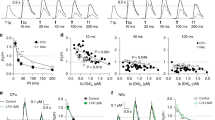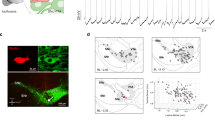Abstract
The intrinsic properties of neurons that enable them to maintain depolarized, persistently activated states in the absence of sustained input are poorly understood. In short-term memory tasks, individual prefrontal cortical (PFC) neurons can maintain persistent action potential output during delay periods between informative cues and behavioral responses. Dopamine and drugs of abuse alter PFC function and working memory, possibly by modulating intrinsic neuronal properties. Here we used patch-clamp recording of layer 5 PFC pyramidal neurons to identify a postsynaptic depolarization that was evoked by action potential bursts and mediated by metabotropic glutamate receptor 5 (mGluR5). This depolarization occurred in the absence of recurrent synaptic activity and was reduced by a dopamine D1 receptor (D1R) protein kinase A pathway. After behavioral sensitization to cocaine, the depolarization was substantially diminished and D1R modulation was lost. We propose that burst-evoked intrinsic depolarization is a form of short-term cellular memory that is modulated by dopamine and cocaine experience.
This is a preview of subscription content, access via your institution
Access options
Subscribe to this journal
Receive 12 print issues and online access
$209.00 per year
only $17.42 per issue
Buy this article
- Purchase on Springer Link
- Instant access to full article PDF
Prices may be subject to local taxes which are calculated during checkout







Similar content being viewed by others
References
Goldman-Rakic, P.S. Regional and cellular fractionation of working memory. Proc. Natl. Acad. Sci. USA 93, 13473–13480 (1996).
Funahashi, S. & Takeda, K. Information processes in the primate prefrontal cortex in relation to working memory processes. Rev. Neurosci. 13, 313–345 (2002).
Winstanley, C.A. et al. DeltaFosB induction in orbitofrontal cortex mediates tolerance to cocaine-induced cognitive dysfunction. J. Neurosci. 27, 10497–10507 (2007).
George, O., Mandyam, C.D., Wee, S. & Koob, G.F. Extended access to cocaine self-administration produces long-lasting prefrontal cortex-dependent working memory impairments. Neuropsychopharmacology 33, 2474–2482 (2008).
Goldman-Rakic, P.S. Cellular basis of working memory. Neuron 14, 477–485 (1995).
Seung, H.S. et al. Stability of the memory of eye position in a recurrent network of conductance-based model neurons. Neuron 26, 259–271 (2000).
Wang, X.J. Synaptic reverberation underlying mnemonic persistent activity. Trends Neurosci. 24, 455–463 (2001).
Egorov, A.V., Hamam, B.N., Fransén, E., Hasselmo, M.E. & Alonso, A.A. Graded persistent activity in entorhinal cortex neurons. Nature 420, 173–178 (2002).
Fowler, M.A., Sidiropoulou, K., Ozkan, E.D., Phillips, C.W. & Cooper, D.C. Corticolimbic expression of TRPC4 and TRPC5 channels in the rodent brain. PloS ONE 2, e573 (2007).
Homayoun, H., Stefani, M.R., Adams, B.W., Tamagan, G.D. & Moghaddam, B. Functional interaction between NMDA and mGlu5 receptors: effects on working memory, instrumental learning, motor behaviors, and dopamine release. Neuropsychopharmacology 29, 1259–1269 (2004).
Homayoun, H. & Moghaddam, B. Bursting of prefrontal cortex neurons in awake rats is regulated by metabotropic glutamate 5 (mGlu5) receptors: rate-dependent influence and interaction with NMDA receptors. Cereb. Cortex 16, 93–105 (2006).
Chiamulera, C. et al. Reinforcing and locomotor stimulant effects of cocaine are absent in mGluR5 null mutant mice. Nat. Neurosci. 4, 873–874 (2001).
Otani, S. et al. Dopamine receptors and groups I and II mGluRs cooperate for long-term depression induction in rat prefrontal cortex through converging postsynaptic activation of MAP kinases. J. Neurosci. 19, 9788–9802 (1999).
Greene, C.C., Schwindt, P.C. & Crill, W.E. Properties and ionic mechanisms of a metabotropic glutamate receptor-mediated slow afterdepolarization in neocortical neurons. J. Neurophysiol. 72, 693–704 (1994).
Hartmann, J. et al. TRPC3 channels are required for synaptic transmission and motor coordination. Neuron 59, 392–398 (2008).
Groenewegen, H.J. Organization of the afferent connections of the mediodorsal thalamic nucleus in the rat, related to the mediodorsal-prefrontal topography. Neuroscience 24, 379–431 (1988).
Carr, D.B. & Sesack, S.R. Dopamine terminals synapse on callosal projection neurons in the rat prefrontal cortex. J. Comp. Neurol. 425, 275–283 (2000).
Watanabe, M., Kodama, T. & Hikosaka, K. Increase of extracellular dopamine in primate prefrontal cortex during a working memory task. J. Neurophysiol. 78, 2795–2798 (1997).
Phillips, A.G., Ahn, S. & Floresco, S.B. Magnitude of dopamine release in medial prefrontal cortex predicts accuracy of memory on a delayed response task. J. Neurosci. 24, 547–553 (2004).
Vijayraghavan, S., Wang, M., Birnbaum, S.G., Williams, G.V. & Arnsten, A.F. Inverted-U dopamine D1 receptor actions on prefrontal neurons engaged in working memory. Nat. Neurosci. 10, 376–384 (2007).
Williams, G.V. & Goldman-Rakic, P.S. Modulation of memory fields by dopamine D1 receptors in prefrontal cortex. Nature 376, 572–575 (1995).
Wang, J. & O'Donnell, P. D(1) dopamine receptors potentiate NMDA-mediated excitability increase in layer 5 prefrontal cortical pyramidal neurons. Cereb. Cortex 11, 452–462 (2001).
Yang, C.R. & Seamans, J.K. Dopamine D1 receptor actions in layers 5–6 rat prefrontal cortex neurons in vitro: modulation of dendritic-somatic signal integration. J. Neurosci. 16, 1922–1935 (1996).
Dong, Y. et al. Cocaine-induced plasticity of intrinsic membrane properties in prefrontal cortex pyramidal neurons: adaptations in potassium currents. J. Neurosci. 25, 936–940 (2005).
Peterson, J.D., Wolf, M.E. & White, F.J. Repeated amphetamine administration decreases D1 dopamine receptor-mediated inhibition of voltage-gated sodium currents in the prefrontal cortex. J. Neurosci. 26, 3164–3168 (2006).
Young, C.E. & Yang, C.R. Dopamine D1/D5 receptor modulates state-dependent switching of soma-dendritic Ca2+ potentials via differential protein kinase A and C activation in rat prefrontal cortical neurons. J. Neurosci. 24, 8–23 (2004).
Homayoun, H. & Moghaddam, B. Progression of cellular adaptations in medial prefrontal and orbitofrontal cortex in response to repeated amphetamine. J. Neurosci. 26, 8025–8039 (2006).
Hanes, D.P. & Schall, J.D. Neural control of voluntary movement initiation. Science 274, 427–430 (1996).
Rainer, G., Asaad, W.F. & Miller, E.K. Memory fields of neurons in the primate prefrontal cortex. Proc. Natl. Acad. Sci. USA 95, 15008–15013 (1998).
Rae, M.G. et al. Role of Ca2+ stores in metabotropic l-glutamate receptor-mediated supralinear Ca2+ signaling in rat hippocampal neurons. J. Neurosci. 20, 8628–8636 (2000).
Nakamura, T. et al. Synergistic release of Ca2+ from IP3-sensitive stores evoked by synaptic activation of mGluRs paired with backpropagating action potentials. Neuron 24, 727–737 (1999).
Cooper, D.C., Chung, S. & Spruston, N. Output-mode transitions are controlled by prolonged inactivation of sodium channels in pyramidal neurons of subiculum. PLoS Biol. 3, e175 (2005).
Gao, W.J., Krimer, L.S. & Goldman-Rakic, P.S. Presynaptic regulation of recurrent excitation by D1 receptors in prefrontal circuits. Proc. Natl. Acad. Sci. USA 98, 295–300 (2001).
Madeja, M. Do neurons have a reserve of sodium channels for the generation of action potentials? A study on acutely isolated CA1 neurons from the guinea-pig hippocampus. Eur. J. Neurosci. 12, 1–7 (2000).
Cooper, D.C. et al. Psychostimulant-induced plasticity of intrinsic neuronal excitability in ventral subiculum. J. Neurosci. 23, 9937–9946 (2003).
Yoshida, M., Fransén, E. & Hasselmo, M.E. mGluR-dependent persistent firing in entorhinal cortex layer III neurons. Eur. J. Neurosci. 28, 1116–1126 (2008).
Montell, C. The TRP superfamily of cation channels. Sci. STKE 2005, re3 (2005).
Lopez-Bendito, G., Shigemoto, R., Fairen, A. & Lujan, R. Differential distribution of group I metabotropic glutamate receptors during rat cortical development. Cereb. Cortex 12, 625–638 (2002).
Lujan, R. et al. Perisynaptic location of metabotropic glutamate receptors mGluR1 and mGluR5 on dendrites and dendritic spines in the rat hippocampus. Eur. J. Neurosci. 8, 1488–1500 (1996).
Hagenston, A.M., Fitzpatrick, J.S. & Yeckel, M.F. mGluR-mediated calcium waves that invade the soma regulate firing in layer V medial prefrontal cortical pyramidal neurons. Cereb. Cortex 18, 407–423 (2008).
Cooper, D.C. The significance of action potential bursting in the brain reward circuit. Neurochem. Int. 41, 333–340 (2002).
Gaspar, P., Bloch, B. & Le Moine, C. D1 and D2 receptor gene expression in the rat frontal cortex: cellular localization in different classes of efferent neurons. Eur. J. Neurosci. 7, 1050–1063 (1995).
Zhang, X.F., Hu, X.T. & White, F.J. Whole-cell plasticity in cocaine withdrawal: Reduced sodium currents in nucleus accumbens neurons. J. Neurosci. 18, 488–498 (1998).
Bechara, A. et al. Decision-making deficits, linked to a dysfunctional ventromedial prefrontal cortex, revealed in alcohol and stimulant abusers. Neuropsychologia 39, 376–389 (2001).
Grant, S. et al. Activation of memory circuits during cue-elicited cocaine craving. Proc. Natl. Acad. Sci. USA 93, 12040–12045 (1996).
Breiter, H.C. et al. Acute effects of cocaine on human brain activity and emotion. Neuron 19, 591–611 (1997).
McFarland, K., Lapish, C.C. & Kalivas, P.W. Prefrontal glutamate release into the core of the nucleus accumbens mediates cocaine-induced reinstatement of drug-seeking behavior. J. Neurosci. 23, 3531–3537 (2003).
Perlstein, W.M. et al. Relation of prefrontal cortex dysfunction to working memory and symptoms in schizophrenia. Am. J. Psychiatry. 158, 1105–1113 (2001).
Koenigs, M. et al. Focal brain damage protects against post-traumatic stress disorder in combat veterans. Nat. Neurosci. 11, 232–237 (2008).
Hu, H.Z. et al. 2-aminoethoxydiphenyl borate is a common activator of TRPV1, TRPV2, and TRPV3. J. Biol. Chem. 279, 35741–35748 (2004).
Acknowledgements
We thank K. Huber (University of Texas Southwestern Medical Center at Dallas) for the mGluR1 and mGluR5 wild-type and knockout mice. This work was supported by National Institute on Drug Abuse grant R01-DA24040 (to D.C.C.), NIDA K award K-01DA017750 (to D.C.C.), a NARSAD Young Investigator award (to D.C.C.), National Institute on Drug Abuse institutional training grant T32-DA7290 (to M.A.F.), the Onassis Public Benefit Foundation (to K.S.), a Gulf War Syndrome contract from the US Department of Veterans Affairs and Veterans Affairs IDIQ contract VA549-P-0027 (awarded and administered by the Dallas, Texas, VA Medical Center). This paper is dedicated to the memory of Francis J. White, a close friend and mentor.
Author information
Authors and Affiliations
Contributions
K.S., F.-M.L., E.D.O. and D.C.C. conducted the patch-clamp experiments. K.S. and D.C.C. wrote the manuscript. M.A.F. performed behavioral experiments. C.P. carried out immunoblot experiments, and R.X. and M.X.Z. performed calcium imaging experiments in HEK cells. F.J.W. and D.C.C. supervised the project.
Corresponding author
Supplementary information
Supplementary Text and Figures
Supplementary Figures 1–5 and Supplementary Table 1 (PDF 1820 kb)
Rights and permissions
About this article
Cite this article
Sidiropoulou, K., Lu, FM., Fowler, M. et al. Dopamine modulates an mGluR5-mediated depolarization underlying prefrontal persistent activity. Nat Neurosci 12, 190–199 (2009). https://doi.org/10.1038/nn.2245
Received:
Accepted:
Published:
Issue Date:
DOI: https://doi.org/10.1038/nn.2245
This article is cited by
-
Effects of blocking mGluR5 on primate dorsolateral prefrontal cortical neuronal firing and working memory performance
Psychopharmacology (2021)
-
Enhancement of dendritic persistent Na+ currents by mGluR5 leads to an advancement of spike timing with an increase in temporal precision
Molecular Brain (2018)
-
Insular cortex mediates approach and avoidance responses to social affective stimuli
Nature Neuroscience (2018)
-
Opposing presynaptic roles of BDNF and ProBDNF in the regulation of persistent activity in the entorhinal cortex
Molecular Brain (2016)
-
Long-Lasting Sound-Evoked Afterdischarge in the Auditory Midbrain
Scientific Reports (2016)



